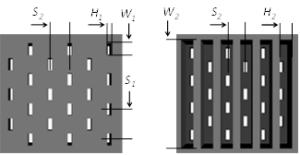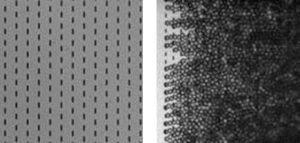Highlights Nano4AgroFood
In the NanoNextNL program a number of projects was started and lead to innovative science and application. Below you will find a number of examples of projects from the NanoNextNL program.
Accurately mixing oil and water
Mayonnaise, milk, hair conditioner and medicinal ointment: all examples in which oil and water are mixed. But oil and water do not mix well. At Wageningen University, a chip has been developed that can create this type of emulsions very accurately. ‘The chip can be used to mix any substance that we add to it.’
The EDGE (Edge-based Droplet GEneration) chip created by professor Karin Schroën and PhD student Sami Sahin is technically a thick sieve, they explain. ‘The chip is made up of several layers of microchannels. For a modest production volume, we can produce twenty cubic metres of product per hour for oil percentages of up to thirty percent,’ says the PhD student. ‘And we have demonstrated that it is possible to make oil droplets that are all exactly ten micrometres in size.’ With the EDGE chip, you can even calibrate the size of the droplets.
The size of the oil droplets determines how creamy a food product tastes. By using this chip, the same creamy taste can be achieved with less fat.
Creamy taste with less fat
The dimensions of the oil droplets are important for a wide range of applications. For example, the size of the oil droplets determines how creamy a food product tastes. As with the current mixing methods the oil droplets produced are not only the large, creamy tasting droplets, but also less desirable small droplets, manufacturers often add slightly more oil than necessary to ensure the desired taste. Using the chip from Wageningen University, all oil droplets are exactly the same size. This way, the same creamy taste can be achieved with less fat.
No overdosing in the case of medicines
The chip can also yield advantages for the production of medicines. For example, you can selectively reach certain organs in the body by using emulsions of oil droplets with specific dimensions. In addition, droplets with the same dimensions always contain exactly the same quantity of active substance. This means you can use the chip to prevent overdosing.
From sixty football fields to office size
‘When Sami Sahin started his PhD research, we had a chip that did the same but would have required a surface area of sixty football fields to produce sufficient amounts. Thanks to Sami’s smart new design, we have reduced that to ten square metres. And because you the chips can be stacked, the complete production facility can now easily fit inside my office,’ says professor Schroën.
Identical droplets
The chip is made of glass in which microchannels have been etched, explain the researchers. ‘We allow a layer of oil to run over a plateau. As there is a pressure difference before and after the plateau, the oil spontaneously forms droplets. The surface forces, viscosity and friction with the walls ensure that these droplets are always exactly the same size.’ By adjusting the shape of the channels and the pressure difference, you can calibrate the droplet size.
Fabrication
Fabricating Sahin’s design was far from easy, says Schroën. ‘Eventually, we found Cytocentrics, a development company that designs and produces microsystems, willing to seek the boundaries of its technology for us.’ ‘Realising Sami’s design was a fantastic challenge,’ says Cytocentrics product engineer Arne Heessels. ‘To ensure that all of the oil droplets are exactly the same size, the channels may not differ from each other in the slightest. We therefore had to etch the holes with exceptional accuracy. We eventually decided to treat the top and bottom of the chip separately. But we had to ensure that the holes in the bottom plate would line up exactly with those in the top plate. That was an exceptionally tough technical challenge. We were therefore extremely pleased when a video showed that the chips made the exact droplets and mixtures that Sami and Karin had intended.’

Fig. left: Schematic 3D representation of multi-EDGE device. Oil is pushed from the bottom side and the droplets emerge at the top side. Fig. right: schematic section view.

Schematic top view (fig. left) and schematic bottom view (fig. right).

Optical micrographs of the top side, before and during emulsification. Droplets are carried away from left to right by the cross flowing continuous phase; please note that the cross-flow is not needed for droplet formation.
Developing and producing a prototype
Sahin received his doctorate at the end of May 2016. Now he wants to develop a prototype with the help of an STW Demonstrator Grant so that the possibilities of the chip can be demonstrated to industry, tells Schroën. ‘We want to increase the yield by a factor of ten and gain an even better understanding of the process.’ ‘In addition, we need to demonstrate that the chip can run 24/7,’ says Sahin. ‘We have a lot of knowledge about the settings you can tweak to create various sizes and quantities of oil droplets, and now we want to share this knowledge with interested manufacturers. This way, we can advise them about the formulas that they must use to realise a final product with the desired properties. This could be the texture of a cream, the final taste experience of a dressing, or the concentrations of active substances in a medicine,’ he says.
Cytocentrics can produce this first prototype and possibly make a small run of these as well. ‘However, once the switch is made to larger volumes, we would like to transfer the technology to a party that can handle bulk production,’ says Heessels.
Demonstrating the advantages
‘The profit margins in the food industry are very small. We must therefore offer a big advantage compared to the current methods. For example, our mixing method uses 90% less energy than the current standard equipment used to produce emulsions (homogenisers), and with our chip we can even improve the properties of the product. By demonstrating how our chip works, we hope that a company will take over its further development, so that the chip will actually be used within the food industry,’ concludes Schroën.
Nine shades of green
Colouring food naturally in all shades of green: Krassimir Velikov and Ashok Patel managed to achieve that in a NanoNextNL project. With their patented method the product retains its green colour even if you heat it or place it in an acidic environment.
For years, the food industry has been searching for natural food pigments to colour food products green. Green is attractive for consumers: they associate such products with ‘fresh’ and ‘natural and eagerly purchase them. However, green is a difficult colour to make. Natural pigments such as chlorophyll are not stable enough if they are heated or placed in an acidic environment. The colour of the product then fades.
Maize starch as a carrier
In a NanoNextNL project, Krassimir Velikov from Utrecht University and Unilver and his colleague Ashok Patel succeeded in attaching yellow and blue pigments to microscopically small spheres of maize protein that continued to move around as spheres in a solution. The researchers attached the yellow natural pigment curcumin and the blue natural pigment indigo carmine to the spheres. By changing the ratio between the yellow and blue colours every conceivable shade of green can be made.
Most of the application opportunities are in liquid products: We can now tailor-make the spheres for a range of applications from drinks to solid food. Many drinks are relatively acidic, which is especially disastrous for traditional colouring methods. However, with our method a drink that is meant to be green also stays green.
Natural, digestible and positive health effects
‘The maize protein ensures that the pigments are protected from external influences. And it is a natural, digestible, completely edible carrier’, says Velikov. ‘Furthermore one of the natural pigments, curcumin, an anti-oxidant of turmeric, could have positive health effects.’
Making the spheres
Making the spheres of maize protein cost a lot of theoretical and experimental effort. First of all the pigments had to be attached in a controlled manner. ‘The two pigments have different attachment mechanisms and that posed a considerable challenge’, says Velikov. But also making the spheres in a controlled manner was far from easy. For food applications in particular, it is vitally important that all of the particles have the same composition and structure so that a consistent taste and texture of the food product is ensured.
Green drinks
Velikov thinks that most of the application opportunities are in liquid products: ‘We can now tailor- make the spheres for a range of applications from drinks to solid food. Many drinks are relatively acidic, which is especially disastrous for traditional colouring methods. However, with our method a drink that is meant to be green also stays green. And because the particles that we use to add the pigments are so microscopically small, the liquid can remain transparent.’
Applications in food and cosmetics
In an STW project entitled ‘Optically functionalised nanoscale particles from water insoluble proteins’ researchers from Utrecht University are searching for applications of this technology within the food and cosmetic industries.
Nano4Society Foundation

University of Twente
Hallenweg 15
7522 NH Enschede
The Netherlands
About Nano4Society
Nano4Society applies nanotechnology within the ecosystem to develop solutions for major social transitions and creating social impact and economic value.
Legal Documents
More information
For more information and your questions, please contact us.



